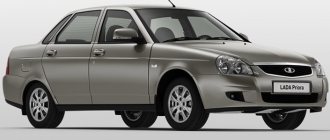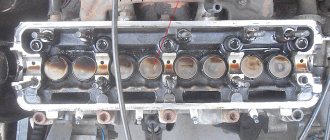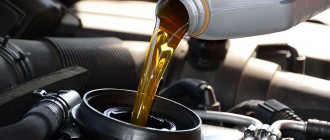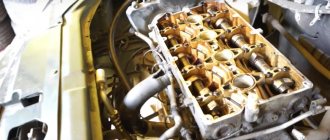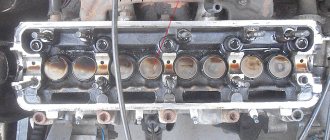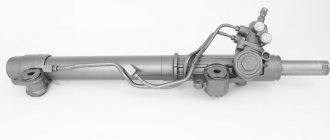All Lada Priora owners have at least once experienced engine oil consumption exceeding the norm and a broken timing belt. Loss of engine oil occurs because:
- – valve stem seals (oil seals) wear out over time and temperature;
- – the valves swing due to worn valve bushings and also break the valve seals;
- – the oil, since the oil seal has little resistance, flows down the valve and enters the combustion chamber.
To prevent this from happening again, it is recommended to replace the connecting rod and piston group in the engine with a plugless one.
Priora pistons repair group 16 valves dimensions
*—parameters and dimensions of products from other manufacturers may differ from those indicated.
For the VAZ 21126 engine, a new design of the connecting rod and piston group was developed. Specialists from the company Nural (Nural), part of the Federal Mogul corporation, took part in the development of the piston engine. For the first time for a VAZ engine, a new T-shaped piston design was chosen. The bottom shape is flat with 4 small recesses.
Due to the use of “thin” piston rings, it was possible to reduce the height of the sealing and fire belt. The use of oil nozzles in the engine to supply oil to the inner surface of the piston ensured a significant reduction in the thermal load on this part. The piston uses a shortened piston pin of the “floating” type, secured with retaining rings and with a diameter of 18 mm. This made it possible, in the piston design, to remove a significant amount of metal in the area of the bosses, thereby increasing the size of the “refrigerator” and reducing the guide sections of the piston skirt. Excess oil is drained into the “refrigerator” area through holes made in the groove for the oil scraper ring. Piston 21126 is manufactured by stamping (forging) and does not have temperature-compensating elements. Reducing the weight of the connecting rod and piston group had a positive effect on improving the dynamic characteristics of the engine.
Basic markings applied to the bottom of the part.
1. Orientation marker - "
» during installation, must point towards the camshaft drive
2. Class marker - one of the symbols (“A”, “B”, “C”) determines the deviation in the outer diameter.
4. Model marker, according to the manufacturer's classification.
Main Dimensions
| Piston class by outer diameter | A | B | C |
| Piston diameter 82.0 (mm) | 81,965-81,975 | 81,985-81,995 | 82,005-82,015 |
The precision manufacturing of the hole for the piston pin ensures a gap of 0.001-0.002 mm and allows the use of a pin of the same size (17.990-17.995 mm).
A number of third-party manufacturers sell pistons in repair sizes - 82.5 mm and 83.0 mm.
Source
general information
The piston in an internal combustion engine is designed to transmit rotational energy to the crankshaft. This energy is produced by combustion of the mixture. When a mixture of air and gasoline explodes, the gases expand. The latter press on the surface of the part and push it. During operation, the piston surface experiences high thermal loads. The pressure in Priora engines can reach 65-80 bar.
During operation, the Priora pistons accelerate at some intervals to a speed of 100 km/h and then slow down to zero, while the operating frequency at 6000 rpm is 200 Hz. When the fuel-air mixture burns, heating in the chambers can reach 1800-2660 degrees. This is several times higher than the temperature at which metal melts. As a result, the strength of the alloy decreases. Various stresses arise in the piston body due to sudden temperature changes, and in addition, stress from pressure and inertia is added during acceleration-deceleration processes at high frequencies.
Defects of VAZ 2170 Priora engine parts
| PISTON | 21126-1004015 |
| Manufacturer | Federal-Mogul Powertrain East LLC. Tolyatti. (Federal Mogul) |
| Piston diameter (nominal), mm: | 82 |
| Piston height, mm: | 45,4 |
| Compression height, mm: | 25,4 |
| Heat zone, mm: | 4,0 |
| Height of the groove for the 1st compression ring, mm: | 1,25 — 1,23 |
| Height of the groove for the 2nd compression ring, mm: | 1,54 — 1,52 |
| Height of the groove for the oil scraper ring, mm: | 2,03 — 2,01 |
| Pin hole offset, mm: | 0,5 |
| Recommended clearance in the cylinder, mm: | 0,040 ±0,012 |
| Piston crown surface: | flat |
| Recess depth for inlet valve, mm: | 1,70 |
| Recess depth for outlet valve, mm: | 1,49 |
| Total volume of samples in the piston, cm 3: | 0,125 ± 0,015 |
| The distance at which the actual diameter of the piston is determined, (from the lower edge of the piston), mm: | 10 |
| Coverage/microprofile: | microprofile |
| Weight, g: | 244 |
| Piston pin | 21126-1004020 |
| Piston pin diameter, mm: | 18 |
| Piston pin length, mm: | 53 |
| Piston rings | |
| Ring height, mm: | 1,2/1,5/2 |
| Retaining rings | 11194-1004022 |
| Note | |
| The piston arrives for assembly and for sale as part of a kit - piston, rings, pin, connecting rod, retaining rings. | |
| Set weight (piston+pin+connecting rod+circlips+piston rings), g: | 796 |
*—parameters and dimensions of products from other manufacturers may differ from those indicated.
Design features.
For the VAZ 21126 engine, a new design of the connecting rod and piston group was developed. Specialists from the company Nural (Nural), part of the Federal Mogul corporation, took part in the development of the piston engine. For the first time for a VAZ engine, a new T-shaped piston design was chosen. The bottom shape is flat with 4 small recesses.
Due to the use of “thin” piston rings, it was possible to reduce the height of the sealing and fire belt. The use of oil nozzles in the engine to supply oil to the inner surface of the piston ensured a significant reduction in the thermal load on this part. The piston uses a shortened piston pin of the “floating” type, secured with retaining rings and with a diameter of 18 mm. This made it possible, in the piston design, to remove a significant amount of metal in the area of the bosses, thereby increasing the size of the “refrigerator” and reducing the guide sections of the piston skirt. Excess oil is drained into the “refrigerator” area through holes made in the groove for the oil scraper ring. Piston 21126 is manufactured by stamping (forging) and does not have temperature-compensating elements. Reducing the weight of the connecting rod and piston group had a positive effect on improving the dynamic characteristics of the engine.
Basic markings applied to the bottom of the part.
1. Orientation marker - “ ” when installed, should indicate the direction towards the camshaft drive
2. Class marker - one of the symbols (“A”, “B”, “C”) determines the deviation in the outer diameter.
4. Model marker, according to the manufacturer's classification.
Main Dimensions
| Piston class by outer diameter | A | B | C |
| Piston diameter 82.0 (mm) | 81,965-81,975 | 81,985-81,995 | 82,005-82,015 |
The precision manufacturing of the hole for the piston pin ensures a gap of 0.001-0.002 mm and allows the use of a pin of the same size (17.990-17.995 mm).
A number of third-party manufacturers sell pistons in repair sizes - 82.5 mm and 83.0 mm.
Device
In order for the crank assembly to serve in such difficult conditions, the part must be light and wear-resistant. The alloy has high thermal conductivity, which ensures rapid cooling when heated.
The outer surface is formed in such a way that there is never a risk of the part jamming inside the combustion chamber. Gases must not enter the engine crankcase. Due to the temperature difference between the piston bottom and the skirt, the element is made in a barrel shape. Therefore, it satisfies all the requirements.
To compensate for skirt deformations during operation, the mechanism is made with a so-called “anti-ellipse”. The major axis of the part is perpendicular to the finger hole. The top part of the piston is the so-called head. It has a bottom and special grooves. O-rings are installed in them. To ensure that the piston head can withstand high loads, a special protective coating is applied to it.
The grooves for the piston rings are made at a slight angle. This ensures that the outer edges of the rings are positioned higher than the inner ones. The manufacturer prevents the groove cross-section from sloping downward at high temperatures. This is not the last characteristic that distinguishes the pistons. Priora is equipped with elements that “slide” in the combustion chamber. To do this, their working surface is coated with special compounds. In order for the part to run in better, coatings are applied that will wear out over time during the running-in process. This is often a phosphated tin compound. This coating also reduces the occurrence of scratches during cold starts. Antifriction materials remain on the piston forever. They prevent cracking of the working part of the part and erosion.
Non-stick pistons
Non-stick pistons have valve grooves at the top so they do not “stick” into the valves, hence the name. There are 3 types of plugless pistons for Lada Priora: STI, STK, AVTRAMAT.
STI pistons
These are forged pistons; they are manufactured at a plant in Tolyatti. They have deep grooves and a flat bottom. The skirts are covered with graphite. Recommended for installation on an engine that requires alignment of the plane of the cylinder head.
To repair engine 21126 (1.6 l 16 valves), a piston STI 216.08 with a diameter of 82.0 mm is intended. Pins and stoppers are not included. If repairs without increasing the diameter are impossible, then pistons 216.09, 216.10, 217.16 or 217.17 are used and they are accompanied by piston rings with diameters of 82.5 mm, 83.0 mm, or 84.0 mm.
STK pistons
STK pistons are manufactured at the Samara Trading Company. These pistons are the “medicine” for piston groups.
Their alloy is different from the alloy of factory pistons. The piston skirts are similar to the factory piston skirts and are coated with a malicot anti-friction coating.
Their disadvantage is that not all pistons have normal side grooves for oil drainage. Therefore, to prevent them from eating oil, you need to drill the missing grooves with a 2-4 mm drill. With a 3.5 - 4 mm drill, you need to drill carefully, especially on the right, so that the drill does not jump out, catching on a sharp edge.
Since 2022, STK began making new models of pistons. They have 2 oil drains on the side that extend to the middle of the groove and there is a transition from the oil drain slot to the holes, like factory pistons. But there are now not 2, but 4 holes for draining oil on each side, which improves oil drainage and increases the strength of the piston.
The VAZ 21126 Priora piston group with a diameter of 82 or 82.5 mm is designed for the Lada Priora. Standard equipment: piston, pin, piston rings. It is possible to purchase components separately.
AVTRAMAT pistons
Pistons are manufactured at AVTRAMAT LLC. Their alloy is identical to the alloy of the factory pistons, and the skirt is much wider.
To avoid oil consumption, you need to use a 2 mm drill to drill holes at the ends for the oil drain (since they are not made at the factory). As the drill begins to pass through, bore the hole down to drain oil from the lower edge of the oil scraper ring.
To repair the VAZ 21126 engine, the piston 21126 - 1004015 M-U is intended.
Advantages of pistons with valve grooves
- The engine is not damaged, since the valves fall into the grooves when the timing belt breaks.
- The pistons do not overheat and rarely burn out or crack.
Disadvantages of pistons with valve grooves
- The compression of the working fuel mixture worsens and the volume of the combustion chamber increases, and as a result, engine power decreases by 10% and fuel consumption increases by 10%.
- When a mixture of gasoline and air is compressed, the pressure of the piston is distributed unevenly.
Reasons for installation
Here guys, everything is individual, as I have already written in many articles, if you follow the technical maintenance regulations, install original or high-quality spare parts, then your “iron horse” will not let you down - the units will operate in normal modes.
However, you always want to save money or tune up your car, but this raises some questions. Namely:
1) If we save, in particular, on the timing system (belt and other rollers) by installing low-quality parts, then their replacement interval drops significantly. For example, as a standard on our VAZs, the timing belt is changed after about 30 - 50,000 km, but if cheap "non-original" ones are installed, it can last about 5,000 - 10,000 km, or maybe less.
2) Also, some “people’s tuners” who try to squeeze more power out of our PRIORs often install air compressors on the engines. But most of the parts are not designed for such speeds (7000 - 9000), just as the gas distribution system is not designed. As you guessed, the connecting link of the belt simply breaks.
So what should we do? After all, you want to save money and drive? There is a solution (damn, just like in the advertisement) - “stickless pistons”!
What compression should the VAZ-2109 injector and carburetor have?
What is engine compression. How to check the compression of a VAZ 2109? Often, car owners are faced with vibration that unexpectedly occurs when driving at idle speed, and large fuel combustion. There are several reasons for this deficiency, for example, problems with spark plugs or malfunctions of the fuel system.
Poor engine compression can also lead to such consequences. If diagnostics of the fuel system shows that everything is in order, you need to check the compression in the cylinders.
Compression is the maximum pressure in the cylinder that occurs at the end of the compression stroke (at the moment the piston reaches top dead center). To measure compression there is a special device called a compression gauge (a pressure gauge with a hose and a fitting at the end).
What is engine compression. How to check the compression of a VAZ 2109?
Poor compression in the cylinders leads to the following consequences:
- fuel consumption increases;
- dynamics deteriorate (acceleration);
- the accelerator responds poorly to the pedal;
- poor “traction”;
- black exhaust appears.
Checking the compression of the VAZ 2109 engine with your own hands
- Before measuring compression, you need to check the valve clearances and adjust them.
- Warm up the engine to 70-80 degrees.
- Turn off the engine, remove the spark plugs (to do this, use a spark plug wrench).
- Disconnect the fuel hose and clamp it to prevent fuel from leaking.
- Remove the central drive from the ignition coil.
- Use a compression gauge installed in the spark plug socket to determine the indicators. Start checking from the first cylinder. Each cylinder must be checked separately.
- At this time, the assistant must turn the starter so that the compression gauge can record the resulting pressure.
- Record the device indicators. The minimum permissible compression is 10 kg/sq. cm, and the spread between the cylinders should not exceed 1 kg/sq. see. If your readings differ greatly from each other, we can conclude that there is wear on the compression rings, valves that do not fit well on the seats, or problems with the tightness of the cylinder head gasket.
"Avtramat"
These are Ukrainian-made parts. Pistons are manufactured at a Kharkov plant. The part is produced by casting. The alloy completely replicates that of the original spare parts. The factory dimensions of the VAZ pistons are also repeated. But unlike the original, the Ukrainian element has deeper samples. This gives it a lot of advantages over the standard part if the timing belt breaks. As for the compression ratio, it remained unchanged. Therefore, if you install these products, the difference in the power characteristics of the engine will not be noticeable.
Due to the fact that the samples are increased, the area of the combustion chamber has increased slightly, the efficiency should be lower compared to standard spare parts. However, the numbers differ slightly. So, the figure is 53.2 cm 2 for the original and 53.3 cm 2 for the Avtramat. In practice, this is completely unnoticeable. There is one more advantage that these pistons have. Priora (the price of parts is 3 times less - 2 thousand rubles, than for products from STI - almost 7 thousand) will be inexpensive to maintain if you use these products.
These parts are produced at the enterprise in Samara. Their technical characteristics are practically no different from Avtramat products. The difference is in the weight of the piston. Due to the higher weight, the acceleration dynamics of the car are reduced. Also, STK pistons have a higher price.
Minuses
If the piston is light (as much as possible), the motor will gain more power. You can achieve an increase in dynamic characteristics by 5-7%. Pistons with grooves cannot be called light. To make a recess at the top of the part, you need to have a fairly thick wall. This makes it heavier, which is why power is lost.
In addition, these grooves change the compression of the combustible mixture. This also affects the traction of the power unit. To summarize, with the installation of such a part, the engine will lose that same 5% of power. For a 150 hp engine. With. this is 10.5 “horses”. Another drawback is higher fuel consumption. The dimensions of the VAZ pistons are the same as the factory ones, but due to the grooves, the volume of the combustion chamber increases, even if only slightly. Finally, due to increased volumes, compression decreases. Detonation is also increasing.
